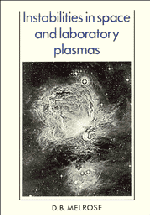Book contents
- Frontmatter
- Contents
- Preface
- Plasma formulary
- Part I Introduction to plasma theory
- 1 Introduction
- 2 The response of an unmagnetized plasma
- Part II Instabilities in unmagnetized plasmas
- Part III Collision-dominated magnetized plasmas
- Part IV Instabilities in magnetized collisionless plasmas
- Appendix A The plasma dispersion function
- Appendix B Bessel functions
- Appendix C Collision frequencies
- Appendix D Transport coefficients
- Bibliographical notes
- References
- List of commonly used symbols
- Author index
- Subject index
- Frontmatter
- Contents
- Preface
- Plasma formulary
- Part I Introduction to plasma theory
- 1 Introduction
- 2 The response of an unmagnetized plasma
- Part II Instabilities in unmagnetized plasmas
- Part III Collision-dominated magnetized plasmas
- Part IV Instabilities in magnetized collisionless plasmas
- Appendix A The plasma dispersion function
- Appendix B Bessel functions
- Appendix C Collision frequencies
- Appendix D Transport coefficients
- Bibliographical notes
- References
- List of commonly used symbols
- Author index
- Subject index
Summary
Preliminary remarks
One of the most obvious features of the plasma state is the rich variety of wave motions which plasmas can support. Waves of a particular kind are said to be in a particular wave mode. The idea of a wave mode is familiar from other contexts. For example in a compressible gas there are sound waves and, if there is a gravitational field present, there are also internal gravity waves. These waves have specific dispersion relations, which relate the frequency ω to the wave vector k. For sound waves and internal gravity waves the dispersion relations are ω = kcs and ω = (gk)½ respectively, where cs is the sound speed and g is the gravitational acceleration. One could cite numerous examples of wave modes in other media, e.g. spin waves in ferromagnetic media and seismic waves in the solid Earth, each of these is characterized by its dispersion relation and other properties which determine the nature of the wave motion. The wave modes of a plasma depend on the plasma properties and these are described in terms of various plasma parameters. Of particular importance are the natural frequencies of the plasma: the electron plasma frequency ωp, the electron cyclotron frequency Ωe, the corresponding ion frequencies ωpi and Ωi, and various collision frequencies (vei, vee, vii) between electrons (e) and ions (i).
- Type
- Chapter
- Information
- Instabilities in Space and Laboratory Plasmas , pp. 3 - 16Publisher: Cambridge University PressPrint publication year: 1986



